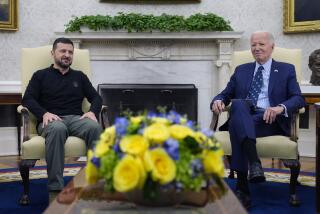Let’s Put Our Money Where Our Mouth Is in Philippines
- Share via
MANILA — Maj. Gen. Delvin Castro, retired commander of the Philippine military forces in Mindanao, rightly noted recently that “the key to which revolution wins, President (Corazon) Aquino’s or the guerrillas’, is the economy . . . . You Americans have the key.”
When former President Ferdinand E. Marcos was faltering, Congress estimated that it would take $5 billion to upgrade American bases on Guam in the event that the United States could not continue to use Clark Air Base and Subic Bay Naval Base in the Philippines. Even fiscally conservative Republicans knew that we would have to spend the money if we were to continue to counter Soviet power projection and maintain stability in the South Pacific and the Indian Ocean.
Now, amid U.S.-Philippine squabbling over what to call the money--”rent” vs. “aid”--there also is a conflict over the control and application of the funds. U.S. law prevents the use of the word rent for such expenditures as a control factor because aid money requires an accounting of how those tax dollars are spent. But it annoys Filipinos that money owed them for the use of facilities on their land is called “aid.”
It is a matter of Philippine national pride and an indication of their country’s sovereignty that they be able to use the money as they see fit--but there are restrictions on its use if it is classified as aid. In June the United States gave the Philippine government $200 million of essentially non-accountable “budgetary support.” Such support helps to ease the dilemma, but the real solution would be for the United States to continue to offer both non-accountable budgetary support and aid.
The current discord, however, is causing diplomatic tensions to build at a quantum rate. By the time Aquino visits the United States on Sept. 17, the atmosphere will be extremely volatile. Secretary of State George P. Shultz and others continue to fuel the fire every time they speak in terms of “aid,” calling into question our own sensitivity and diplomatic skills.
Meanwhile, Philippine nationalist extremists and communists make use of this issue to drive a deeper wedge into our relationship. While there is a profound reservoir of respect and love between both countries, the situation now is like a marriage dissolving over a money problem while an outsider mocks both parties.
Egypt, a non-traditional ally, receives more than $2 billion annually in combined U.S. economic and military aid. Yet we have placed the linchpin of the Pacific region on rations, a country whose close relationship with the United States was forged by the blood spilled as allies in three wars. U.S. excuses abound for our foot-dragging in disbursing economic aid to the Philippines: They range from Gramm-Rudman budget cuts to a need to wait and see if the Aquino government can survive.
Our slow response in assisting the Philippine government sends distinct signals to the economic community. The United States pledged more than $505 million when the new government came to power, but it has yet to dispense nearly $263 million, of which roughly half is earmarked to create jobs. These jobs are needed immediately to continue the stabilization process.
Meanwhile, American and Japanese companies, which through economic investments could bring about a dynamic change in the Philippines, take the U.S. government’s slow approach as a sign to proceed cautiously in the region. A host of U.S. officials express the right sentiments, but their talk is not backed by aggressive, creative assistance. To implement a rapid peacetime Marshall Plan in cooperation with the Philippine government and the country’s private business community would save their democracy and consequently our “rented” bases. It would also keep the human as well as the monetary costs well below those of an insurgency out of control.
In the interim, while the United States dawdles, Philippine intelligence sources are documenting evidence of increased efforts by the New Peoples Army and the Vietnamese to destabilize the fledgling government. Recent NPA ambushes, which were staged as a show of strength for the domestic and international media, only prove that the advice--”take the cause away from the guerrillas”--of retired Maj. Gen. Edward G. Lansdale, the famous Philippine expert of the 1950s, is being ignored.
Most insurgents in the Philippines continue to rebuff sincere efforts to integrate them into the nonviolent democratic process because there is no reason or incentive at the “rice roots” level to quit. Amateurish efforts like those of Marcos’ former vice presidential running mate, Arturo Tolentino, who on July 6 attempted to declare himself acting president, will produce far more destabilizing and dangerous results in the future if poor Filipinos do not start to feel some economic improvement.
Until the United States provides adequate money and support, Filipinos will continue to be faced with the necessity of having to “pick the lock” on the door to economic revitalization. Maintaining the status quo is not Aquino’s aim, nor can it be. She already has provided momentum for social and political change. In order to achieve a successful redemocratization, however, Aquino must be provided with the proper tools to truly affect the disparate economic situation. The United States holds the key.
More to Read
Sign up for Essential California
The most important California stories and recommendations in your inbox every morning.
You may occasionally receive promotional content from the Los Angeles Times.










